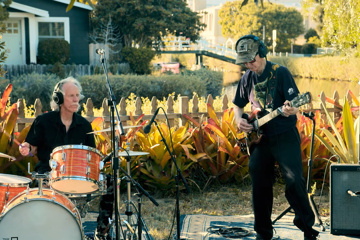In a move that came out of left field for much of the radio industry, one of Australia’s largest radio networks, ARN Media, has made a $330 million bid to buy rival Southern Cross Media.
Australian Radio Network’s brands include KIIS Network, Pure Gold Network, CADA, Regional, iHeartRadio and iHeartPodcast Network.
The bid is in partnership with Sydney-based private equity turnaround specialist Anchorage Capital Partners, which invests in companies in Australia, NZ and Southeast Asia with turnovers over $100 million.
Southern Cross Media (aka Southern Cross Austereo) has the Hit and Triple M networks. In the first half of 2023, it generated $258.8 million, net income of $14.6 million (down 13% from the first half of 2022) and a profit margin of 5.7%, which was down from 6.5% in 1H 2022.
Not surprisingly, this redrawing of the radio landscape has music executives worried about how that will affect the level of Australian and international music airplay.
“The short answer is, yes, there’ll be less music being played,” agrees James Manning, Editor-in-Chief of Mediaweek and one-time artist manager and community radio broadcaster.
Don't miss a beat with our FREE daily newsletter
“There might be less broadcasters playing music because the networks will be looking to save money by cutting costs. Once you get a private equity firm (involved), they’ll want to make changes and on-sell the business. So they have to make it more profitable.”
A former major label publicist who now works mostly with indie acts tells TheMusic.com.au on condition of anonymity, “There’s nothing positive about this buy-out from my viewpoint. There’ll definitely be less music played.
“As it is, it’s almost impossible for any new music from indie labels to get airplay from a major commercial radio station. Even if you got something that would fit a Hit or KIIS or Nova, it only has a chance if it researches to buggery or has millions of streams. It’s a Catch-22.
“At least if you got turned down by one network, you could try the other. Now it’d be a fat chance!
“Commercial radio claims to play 23% [of] Australian music. The only place to hear great new Aussie music is on community radio, which has programs that are 100% Aussie or only play brand new tracks.”
What commercial radio needs, he suggests, is to go back to the early days of FM when a station would rotate four or five tracks out of a single album.
Green Light
If the buy-out gets the green light from authorities, the assets will be split between ARN Media and a new company formed by Anchorage Partners.
“It will result in two separate, national media organisations that will compete independently of each other on metro and regional radio, and more broadly,” ARN Media revealed.
Under the proposal, ARN Media will operate “a focused metro radio network of 10 stations across Sydney, Melbourne, Brisbane, Adelaide and Perth, anchored by the KIIS and Triple M brands in each of these locations and with differentiated, nationally and locally relevant talent.”
According to an analyst, that “effectively (gives) it clear male and female audiences, access into sports, a wide range of advertisers, and more revenue.”
ARN Managing Director Ciaran Davis said, “ARN is ideally positioned to support and operate an expanded regional radio network, and as a combined group of scale in digital audio is positioned to compete efficiently and effectively with international competitors.”
ARN gets 88 regional radio stations (up from its current 47), complete ownership of Canberra’s Mix 106.3 and 104.7 FM, and its own digital audio business.
Anchorage, in turn, will own and operate a separate network of eight metro and 35 regional radio stations, house the Pure Gold and Hit networks) and gets Southern Cross’ digital audio business, LiSTNR, and its regional television business.
Regional Cutbacks?
The music industry believes that major cutbacks will continue to take place at regional radio stations.
The publicist relayed: “This is exactly what happened with the merger when Austereo became Southern Cross Austereo in July 2011, and they picked up many regional stations.
“Those stations used to operate independently. It was worth the two-hour, three-hour drive to these regional cities because you knew they’d pick up your track. You could break your song there and then bring it into the cities. But in time, all those stations became syndicated and were playing the same stuff as the metros.”
The general belief in music industry circles is that younger listeners have turned off mainstream radio and find their discoveries on social media and streaming services. “There’s nothing on [the] radio which excites them,” one artist manager told this masthead.
Commercial radio argues this. It points to the GfK Radio Survey this year, which showed it was continuing to attract younger audiences. Those aged 18-24 added 2 hours 25 minutes of listening year on year, tuning in for more than 12 hours a week.
“Younger audiences are continuing to listen to commercial radio in big numbers and are leading the charge to streaming, with 35.1 % of those aged 10-24 listening that way,” said Ford Ennals, CEO of the Commercial Radio & Audio Association.
The GfK data showed streaming radio remained a popular choice, accounting for 26.3% of commercial radio listeners (who amount to 12.1 million), while Time Spent Listening grew by 8 minutes.
Further figures from the seventh Infinite Radio (Australia) study, released in June 2023, showed that digital audio listening was high among Aussies, now numbering 17 million a week.
Weekly listening to online AM/FM/DAB+ radio increased 80% year over year. 27% aged 12+ had listened to online AM/FM/DAB+ radio in the last week, up from 15% in 2022. Within the 12-34 age group, 50% had used TikTok in the week before.
AM/FM DAB+ radio listening grew in-car, along with 84% aged over 18 had driven or ridden in a car had tuned in (up from 80% in 2022); 38% listened to podcasts in-car, from 32% in 2022, and 20% listened to online AM/FM stations, up from 16% in 2022.
Podcast listening via mainstream radio hit an all-time high, with 43% of Aussies listening at least once a month, 33% at least once a week (five episodes a week, and a higher rate than in the United States) and one in ten listening daily.
Manning doubts that an ARN take-over of SCA would see a distinct bias against local music. “I don’t think anyone taking over a radio station is going to play less or more Australian music. They’ll play what they think the market wants. If they think their listeners want more Australian music, they’ll play it.”
He suggests record companies invest more in Australian talent rather than rely on the cheaper option of plugging overseas records.















